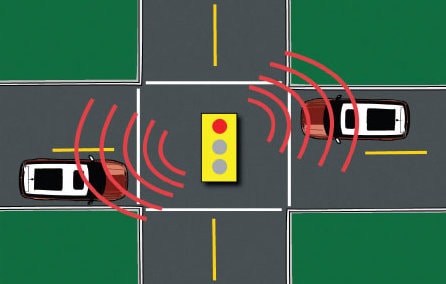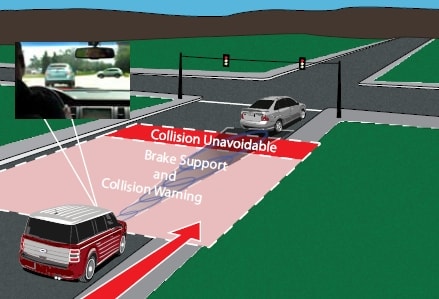The automotive industry is in creative turmoil these days, as the emergence from the financial crisis of 2009 brought with it an explosion of plans automakers have for the future. Most of those plans revolve around the launch of new products, or the development of a new type of powertrain, one the competition would never have thought possible. Electric vehicles, plug-in hybrids and natural gas are in the public spotlight, getting all the attention.
In the background, however, a different type of battle is being fought. One for the creation of the real car of the future, smart enough to interact with other vehicles, traffic signs and even whole streets. This time, the battle is not being waged between different automakers, but against time.
In Europe, Volvo is hard at work on the SARTRE project. You can have a look at what SARTRE is all about by following this link. In the US, Ford is working, for a considerable amount of time now, on its own smart vehicle project. One which expands the definition of smart far beyond the confines of a car and is meant to integrate the whole city.
Ford calls it Smart Intersection. Far from being complete, the project is one of the main focuses of Ford's engineers. They all know the work they are doing today will not become a reality in the near future, probably not even in their own lifetime. But their findings will help future generations create the connected roads and car pool we all dream of today.
WHAT A SMART INTERSECTION IS
Ford's Smart Intersection is not actually an intersection. It's a type of relationship the existing infrastructure is planned to have with the cars that pass through the streets, under stop lights and by street signs.
Smart Intersection, developed by Ford’s Research & Innovation Center, comprises two main elements, the infrastructure and the cars themselves. The infrastructure, say a stop light, communicates wirelessly with the car, informing it of an existing situation on the road ahead. The car itself uses GPS signals to tell the infrastructure its position.
The infrastructure actually sees into the future. For instance, if two cars are approaching the intersection from opposite directions, then a traffic light can determine that the two are on a collision course after it analyzes the GPS data received from the cars (speed and direction) and projects them onto the digital map.
Before they enter any given intersection, the cars receive a detailed digital info folder of the intersection from the smart infrastructure. The folder includes a digital map of the intersection, six additional maps of surrounding stop sign intersections and crosswalks, lane-specific GPS location, as well as traffic light status and timing information.
The cars themselves, using the technology available to them (systems such as the Collision Warning), will interpret the data and, after detecting all hazards ahead, will warn the driver about the imminent danger through visual and audio alerts. From there, it's the driver's call.
As a bonus, the cars equipped with the technologies, which allow them to communicate with the intersections, will also be capable to take a snapshot, if you like, of the respective junction. This feature can be used by other motorists in cars equipped with real time traffic gadgets, who can determine whether the intersection is the best one to take on route to their destination.
Making all other automakers fall in line and adopt the needed technology is nearly impossible in the absence of a law or government directive. Despite the fact that the technologies needed for the cars to receive information are available, coming from various sources, on a vast number of models, having thousands, if not millions of intersection turned into AIs is also impossible in the near future.
Smart Intersection, developed by Ford’s Research & Innovation Center, comprises two main elements, the infrastructure and the cars themselves. The infrastructure, say a stop light, communicates wirelessly with the car, informing it of an existing situation on the road ahead. The car itself uses GPS signals to tell the infrastructure its position.
HOW IT WORKS
The concept behind the project is as straight forward as they come, but it will prove to be impossible to implement in the near future, because of the reasons we’ll list below. Ford's idea calls for the traffic infrastructure in a given city to be fitted with monitor technologies that will enable it to track traffic signal status and GPS data on digital maps.The infrastructure actually sees into the future. For instance, if two cars are approaching the intersection from opposite directions, then a traffic light can determine that the two are on a collision course after it analyzes the GPS data received from the cars (speed and direction) and projects them onto the digital map.
Before they enter any given intersection, the cars receive a detailed digital info folder of the intersection from the smart infrastructure. The folder includes a digital map of the intersection, six additional maps of surrounding stop sign intersections and crosswalks, lane-specific GPS location, as well as traffic light status and timing information.
The cars themselves, using the technology available to them (systems such as the Collision Warning), will interpret the data and, after detecting all hazards ahead, will warn the driver about the imminent danger through visual and audio alerts. From there, it's the driver's call.
As a bonus, the cars equipped with the technologies, which allow them to communicate with the intersections, will also be capable to take a snapshot, if you like, of the respective junction. This feature can be used by other motorists in cars equipped with real time traffic gadgets, who can determine whether the intersection is the best one to take on route to their destination.
ADVANTAGES
Needless to say, any type of technology which allows a car to receive relevant information is of particular use for the modern day driver. In fact, Ford started the entire project in response to statistics that show that, in the US, 40 percent of all traffic accidents and 20 percent of crash-related fatalities occur at intersections. The smart intersection would significantly reduce that number, and also help clear congestion in the process.DISADVANTAGES
The entire idea has the big disadvantage of not being feasible for years and years to come. Ford is working on it, has a few prototype cars and intersections, but we all know not all cars driving on the world's roads are Fords.Making all other automakers fall in line and adopt the needed technology is nearly impossible in the absence of a law or government directive. Despite the fact that the technologies needed for the cars to receive information are available, coming from various sources, on a vast number of models, having thousands, if not millions of intersection turned into AIs is also impossible in the near future.


